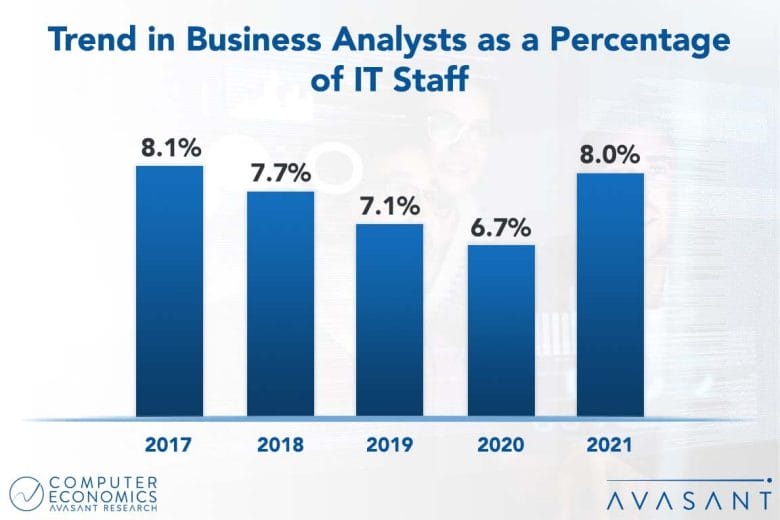Digital transformation has evolved beyond the mere digitalization of analog processes. Most businesses are now rethinking their business processes from the ground up. To do this, they need the business and the IT department to collaborate effectively. Business analysts have a unique role in bridging the gap between the business and IT. They ensure that the digital transformation journey meets business needs. Therefore, it is not surprising that in 2021 there is an increase in business analyst staffing.
As shown in Figure 1 from our full report, Business Analyst Staffing Ratios, business analysts as a percentage of IT staff has increased to 8.0% at the median, returning closer to the 2017 percentage of 8.1%.

Business analysts help navigate the organization along its IT strategy road map. A business analyst not only defines the process to digital transformation but has a clear understanding of the needs of the business as well as the capabilities of the IT organization. Business analysts, in effect, have one foot in the business world and one foot in IT.
Moreover, the foundation of any digital transformation is data. Even today, how data is collected, analyzed, and utilized is a major differentiator for businesses. Aligning data with business solutions—improved services, processes, or products—is aided by business analysts.
We expect a continued increase in business analysts as a percentage of the IT staff, but identifying qualified candidates to fill this role remains a challenge. The wealth of industry expertise, organizational knowledge, and interpersonal skills required for the position is difficult to find in a single individual. Hiring may still be limited, as there is a lack of qualified applicants.
“You can seek out experienced business analysts from other businesses in your sector,” said Tracell Frederick, research analyst/editor for Computer Economics, a service of Avasant Research, based in Los Angeles. “Another approach is to train your own business analysts by identifying senior IT professionals or power users who can transition into this role.”
In our report, we use a broad definition of business analysts. Typical roles include:
Business analysts, who gather user requirements, define business processes, and help design, document, and deploy solutions using information systems.
Any staff member who, regardless of title, serves as a primary liaison between users and IT, represents the user community to the IT group, and ensures that IT systems are used effectively by the organization.
In our full report, we assess typical staffing levels using four metrics: business analysts as a percentage of the IT staff, business analysts as a percentage of the Delivery Group, applications per business analyst, and users per business analyst. We also assess differences by organization size and sector.
This Research Byte is a brief overview of our report on this subject, Business Analyst Staffing Ratios. The full report is available at no charge for Subscribers, or it may be purchased by non-subscribers directly from our website (click for pricing).





